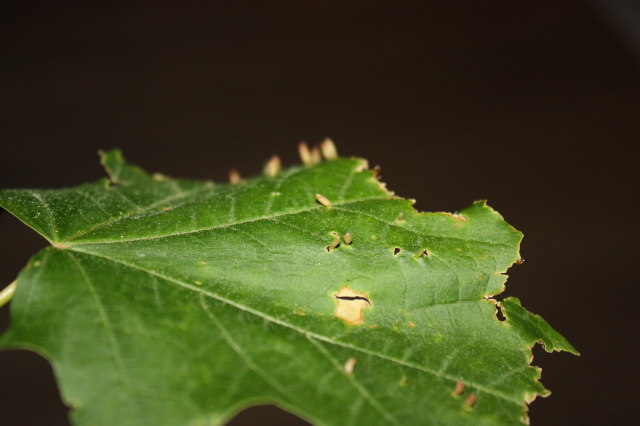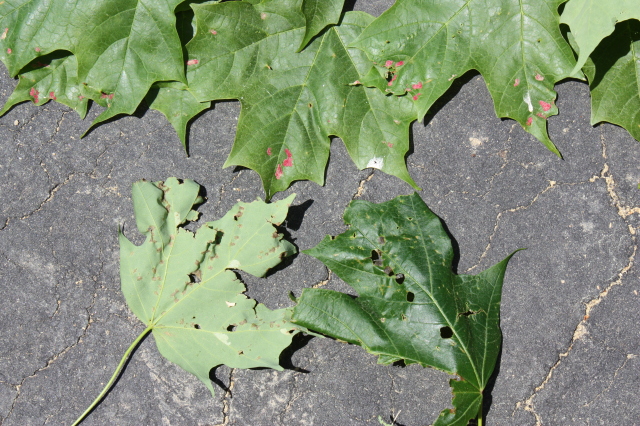Question Maple Leaf
Maple Leaf
QUESTION: I live in Southeast NH and have some beautiful Maple trees in my backyard, though I don't exactly what types of Maples. All are in full foliage except for two that are within about 8 feet of each other. They appear very thin. I just looked closely and saw that some leaves appeared to have been eaten and possibly is what is giving a thin look to the trees. Then I saw what I now believe to be Spindle Gall. I've uploaded a picture to show both the Spindle Gall and eaten part. I understand the Spindle Gall but why does it look like something is eating it? Thanks so much!
ANSWER: Martha:
The gall insects, in this case I believe a mite, usually do not have a significant impact in tree health thus chemical control is usually not warranted. There are plenty of predatory insects out there that keep the "bad guys" in check. The area of gall attachment looks eaten, but may just be an area of weaken tissue caused by the gall insect when the gall was first formed. Or, you may be right, perhaps another insect was searching out a meal as well. For the most part, these insects are curiosities only.
Regards
Steve
---------- FOLLOW-UP ----------
QUESTION: Thanks for your quick reply Steve. When I wrote the note last night I thought it was a gall issue but now I think it's something else. We just went back outside with binoculars and see MANY leaves that appear to be eaten. Not just those two maples as I first believed but some of my neighbor's as well. I only saw the gall in one small area whereas many, many leaves have been eaten - giving the tree a thinning appearance. We couldn't see any critters on the leaves though and with all that's been eaten I figured we see something hanging around on a leaf. My concern is the health of the tree if so many leaves are getting eaten. I haven't seen anything online regarding losing a tree over its leaves getting eaten. Is this a possibility? THANKS!
ANSWER: Martha:
Take a look at several of these "eaten" leaves for any black areas or spots that seem to seem to be associated with the tattered appearance. Look at a lot of leaves, since the black areas (if present) may drop out of the leaf, leaving this tattered look. Let me know if you see these small blackened spots or areas.
Steve
---------- FOLLOW-UP ----------
 Maple Leaves
Maple Leaves
QUESTION: Steve - I don't see any black spots. I know what you're talking about because I've seen them on Maples at another house. I uploaded another image of leaves from a few different trees. One clump of leaves from one tree has something red/fuchsia on the ends which we didn't see alot of. Mostly the leaves look like the 2 leaves in the front. More of a browning with holes. I did find 2 small black beetles that appeared to be mating (if black beetles do in fact mate!). My neighbor mentioned blight which we had on our tomatoes last summer. I saw some other Maples down the street that looked 'thin' too. Thanks...
AnswerMartha:
I do not recognize a disease nor characteristic significant insect from your image. Some of the areas look like "dimples" of sorts plus some distinct holes. The dimples may have been made when the leaf was very young- even before it was fully expanded. It may have been some type of physical injury- maybe some weather event like hail that involved wind blowing that created a series of wounds on that new leaf. There may have been some insect feeding then as well, but the damage looks like it happened early on. I suspect that if the tree is established in the landscape and is being watered well that it will probably do OK. Just be sure to avoid any damage to the trunk with string trimmers and lawnmovers- these are usually death sentences. Remember to rake up and destroy fallen leaves at the end of winter- since these leaves can harbor insects/disease organisms that can cause a problem the following spring.
Steve







